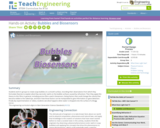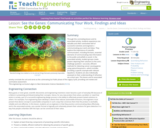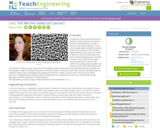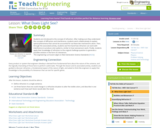
Home page for a hypertext physics course on auditorium acoustics and acoustical design.
- Subject:
- Science
- Material Type:
- Lesson
- Provider:
- Georgia State University
- Date Added:
- 08/28/2023

Home page for a hypertext physics course on auditorium acoustics and acoustical design.

This tutorial looks at the behavior of sound waves, specifically focusing upon sound interference and beats. Learn more about it and then take a short quiz to check your understanding.

Students work in groups to create soap bubbles on a smooth surface, recording their observations from which they formulate theories to explain what they see (color swirls on the bubble surfaces caused by refraction). Then they apply this theory to thin films in general, including porous films used in biosensors, listing factors that could change the color(s) that become visible to the naked eye, and learn how those factors can be manipulated to give information on gene detection. Finally (by experimentation or video), students see what happens when water is dropped onto the surface of a Bragg mirror.

Students learn and use the properties of light to solve the following challenge: "A mummified troll was discovered this summer at our school and it has generated lots of interest worldwide. The principal asked us, the technology classes, to design a security system that alerts the police if someone tries to pilfer our prized possession. How can we construct a system that allows visitors to view our artifact during the day, but invisibly protects it at night in a cost-effective way?"

This pathway explores the properties of light. Light is described as a wave which is able to reflect, refract and diffract when it encounters surfaces. Applications of lights wave properties such as single and double slit diffraction are discussed, as well as how different colours occur as combinations of different frequecnies of light. Probelms are provided to check for understanding.

Make waves with a dripping faucet, audio speaker, or laser. Add a second source or a pair of slits to create an interference pattern.

Learn about the interference and diffraction patterns that result when a wave passes through one or two thin openings using this interactive simulation. A PDF worksheet and a video tutorial are also available. [6:01]
A free CK-12 account is required to view all materials.

A simulation that uses the classic sports stadium "wave" to learn about concepts important to wave motion and interference.
A free CK-12 account is required to view all materials.

Learn about the patterns of wave interference in water in this simulation.
A free CK-12 account is required to view all materials.

Psychology is designed to meet scope and sequence requirements for the single-semester introduction to psychology course. The book offers a comprehensive treatment of core concepts, grounded in both classic studies and current and emerging research. The text also includes coverage of the DSM-5 in examinations of psychological disorders. Psychology incorporates discussions that reflect the diversity within the discipline, as well as the diversity of cultures and communities across the globe.Senior Contributing AuthorsRose M. Spielman, Formerly of Quinnipiac UniversityContributing AuthorsKathryn Dumper, Bainbridge State CollegeWilliam Jenkins, Mercer UniversityArlene Lacombe, Saint Joseph's UniversityMarilyn Lovett, Livingstone CollegeMarion Perlmutter, University of Michigan



By the end of this section, you will be able to:
Compare and contrast the two types of amnesia
Discuss the unreliability of eyewitness testimony
Discuss encoding failure
Discuss the various memory errors
Compare and contrast the two types of interference

Through this concluding lesson and its associated activity, students experience one valuable and often overlooked skill of successful scientists and engineers communicating your work and ideas. They explore the importance of scientific communication, including the basic, essential elements of communicating new information to the public and pitfalls to avoid. In the associated activity, student groups create posters depicting their solutions to the unit's challenge question accurate, efficient methods for detecting cancer-causing genes using optical biosensors which includes providing a specific example with relevant equations. Students are also individually assessed on their understanding of refraction via a short quiz. This lesson and its associated activity conclude the unit and serve as the culminating Go Public phase of the Legacy Cycle, providing unit review and summative assessment.

By this point in the unit, students have learned all the necessary information and conceptualized a design for how an optical biosensor could be used to detect a target strand of DNA associated with a cancer-causing gene as their solution to the unit's challenge question. Now student groups act as engineers again, using a poster format to communicate and prove the validity of the design. Successful posters include a description of refraction, explanations of refraction in a thin film, and the factors that can alter the interference pattern of a thin film. The posters culminate with an explanation of what is expected to be seen in a biosensing device of this type if it were coupled to a target molecule, proven with a specific example and illustrated with drawings and diagrams throughout. All the poster elements combine to prove the accuracy and viability of this method of gene detection. Together with its associated lesson, this activity functions as part of the summative assessment for this unit.

This pathway explores the concept of sound. Sound is described in terms of its wave properties, and properties of sound are explained, such as interference, and the Doppler Effect. There is additional information on how hearing works.

Through four lessons and three hands-on activities, students learn the concepts of refraction and interference in order to solve an engineering challenge: "In 2013, actress Angelina Jolie underwent a double mastectomy, not because she had been diagnosed with breast cancer, but merely to lower her cancer risk. But what if she never inherited the gene(s) that are linked to breast cancer and endured surgery unnecessarily? Can we create a new method of assessing people's genetic risks of breast cancer that is both efficient and cost-effective?" While pursuing a solution to this challenge, students learn about some high-tech materials and delve into the properties of light, including the equations of refraction (index of refraction, Snell's law). Students ultimately propose a method to detect cancer-causing genes by applying the refraction of light in a porous film in the form of an optical biosensor. Investigating this challenge question through this unit is designed for an honors or AP level physics class, although it could be modified for conceptual physics.

How light waves demonstrate their wave nature by reflection, refraction, and diffraction.

Students are introduced to the concept of refraction. After making sure they understand the concepts of diffraction and interference, students work collaboratively to explain optical phenomena that cannot be accounted for via these two mechanisms alone. Then, through the associated activity, students see first-hand how refraction can work with interference to produce color patterns, similar to how nanosensors work. Finally, students apply their knowledge of refraction to the original challenge question to generate a possible solution in the form of a biosensor.